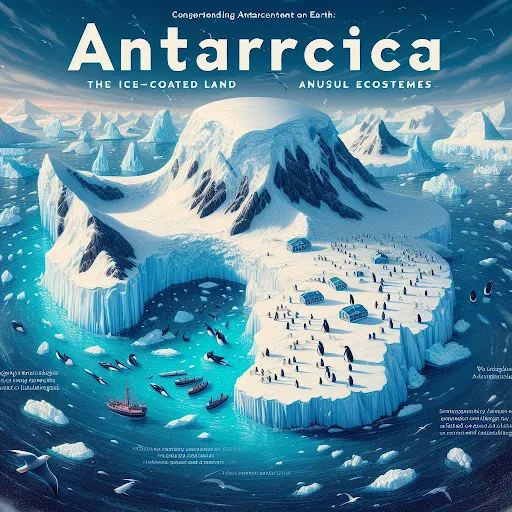For many travelers, traveling to Antarctica is a dream come true because it provides an amazing and one-of-a-kind experience. A trip to Antarctica is a true expedition into the unknown, with breathtaking wildlife encounters and pristine frozen landscapes to be discovered. We'll cover every detail of organizing your Antarctic trip in this extensive guide, from selecting the best expedition to getting ready for the harsh weather and life-changing experiences that lie ahead.
What is the cost of traveling to Antarctica?
A round-trip ticket can set you back anything from $5,000 to $15,000 per person on average. The cost of lodging varies, with low-cost options beginning at $500 per night and high-end options costing more than $2,000 per night.
What is the duration of a trip to Antarctica?
roughly one to three weeks
The majority of Antarctica cruises last between one and three weeks; the multi-location outliers typically stay for approximately one month.
Which age is ideal for traveling to Antarctica?
Children twelve years old and older may have an amazing time in Antarctica. For young eyes, the wildlife, the adventure, and the scenery are particularly captivating. Many Antarctic trips feature talks by geologists, adventurers, marine biologists, photographers, ornithologists, and historians during navigation.
How can I get from India to Antarctica?
Argentina and Chile are the departure points for trips to the Frozen Continent. To make it easier to decide the nation and airport to fly into from India: Fly to Buenos Aires, Argentina, if you are sailing from the port of Ushuaia to Antarctica. Fly to Santiago, Chile, if your Fly & Cruise itinerary includes a flight to Antarctica.
1. Comprehending Antarctica: The Ice-Coated Land
The southernmost continent on Earth, Antarctica is a huge wilderness of ice and snow that is home to amazing natural wonders and unusual ecosystems. Discover the Antarctic's topography, weather, and fauna, which includes seabirds, seals, whales, and penguins that live there in peace and quiet.
2. Selecting Your Trip: Flying vs. CruisingIn
Select the kind of excursion that best fits your interests and style of travel. Consider taking a cruise ship trip, where you may travel through frigid waters, stop at research facilities, and go on Zodiac boat trips to explore the coastline and get up close and personal with wildlife. As an alternative, think about doing a fly-in adventure, which would allow you to spend longer time on the continent by flying from South America to Antarctica.
3. Organizing Your Schedule: Key Events and Activities
Make sure your schedule includes some of the most important sites, like the Antarctic Peninsula, where you can see enormous icebergs, magnificent glaciers, and seal and penguin colonies. Discover more about scientific research done in Antarctica by visiting research stations and historic locations like Port Lockroy.
4. Essential Packing Items: Equipment for Harsh Weather
Packing essentials like insulated clothes, waterproof outer layers, sturdy boots, gloves, caps, and sunglasses can help you prepare for the extreme cold and hard circumstances of Antarctica. Remember to pack a decent camera with telephoto lenses so you may take pictures of the beautiful scenery and wildlife.
5. Health and Safety Factors
Recognize the safety precautions and health requirements for visiting Antarctica, such as the necessity of maintaining adequate heat, hydration, and sun protection. Observe rules on seeing wildlife, protecting the environment, and reducing the impact of humans on the delicate ecosystem.
6. Wildlife Sightings: Whales, Seals, and Penguins
See seals sunning in the sun, whales breaching the frigid waters, and penguins waddling on ice during incredible wildlife encounters in Antarctica. Find more about the conservation efforts to save these species as well as the special adaptations of the fauna in the Antarctic.
7. Cultural Understanding: Research Bases and Field Trips
Visit research sites to get a firsthand look at Antarctic life and interact with experts working on cutting edge projects related to geology, marine biology, and climate change. Find more about the exploration efforts that have shaped our knowledge of this far-off continent and the history of exploration in Antarctica.
8. Preserving Memories Through Photography
Take breathtaking photos of icebergs, wildlife, scenery, and spectacular sunsets to add to your Antarctic vacation. Take use of the natural light, play around with compositions and perspectives, and record unscripted moments that showcase Antarctica's distinct beauty.
In summary, embracing the spirit of Antarctica
Finally, "Antarctic Adventure: Your Ultimate Guide to a Trip of a Lifetime" extends an invitation to experience the spirit of exploration and adventure in one of the few remaining wildernesses on Earth. You will set off on a life-changing adventure that you won't soon forget by learning about Antarctica's unique environment, selecting the ideal expedition, creating an interesting itinerary, packing necessary equipment, putting safety and health first, seeing wildlife, learning about local culture, and taking unforgettable photos.




Comments
Post a Comment